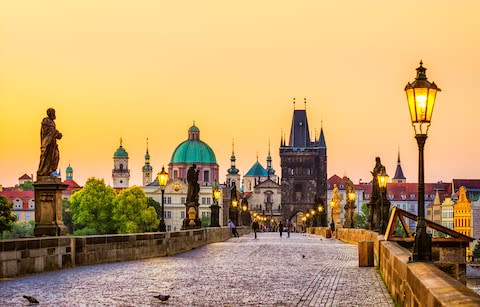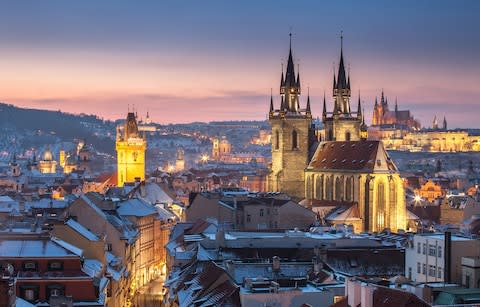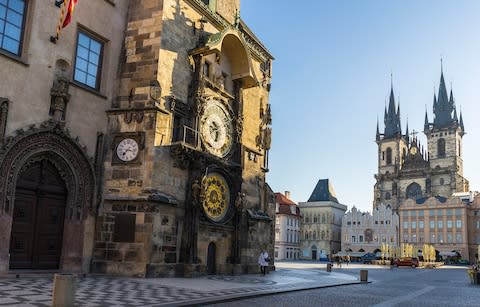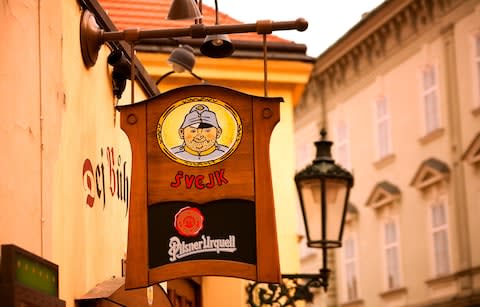Prague cruise port guide

Why go?
Known as “the golden city of 100 spires”, the capital of the Czech Republic combines magnificent medieval architecture, Gothic churches and a deep-rooted musical heritage with a modern café culture and lively bar scene. Prague straddles both sides of the Vltava River – most notably linked by statue-lined Charles Bridge.
Location
Most cruise lines use Prague as a transfer destination, accommodating passengers in central hotels for one or more nights before taking them by coach to or from ships moored on the Danube or Elbe. Only CroisiEurope docks in Prague and vessels tie-up on the western bank overlooked by the castle.
Can I walk to any places of interest?
Prague is a very compact and walkable city, and distances between all the main sights are short. The old town and castle area are separated by the river, which is criss-crossed by bridges. It’s a steep climb to the castle, and comfy shoes are a must on the cobblestone streets.
Getting around
The inexpensive metro, tram and bus network is a user-friendly combined system with one ticket valid on all three. Sold in time increments, starting at 30 minutes, tickets must be validated before boarding. Novel retro trams take in the main tourist areas on the new Zvonařka to Královka line 23.
What to see and do
What can I do in four hours or less?
Most lines offer a half-day walking tour of Prague Old Town, concentrated in the area around Charles Bridge and the main square, with a similar amount of time devoted to a separate tour of the castle.

If you prefer to go at your own pace, with time to linger at market stalls and shops, it’s easy to do this under your own steam armed with a good guide book or app, plus you’ll need to buy the entry tickets for the castle and choose from three options – ranging from the main highlights to all the buildings. Listed in the Guinness Book of Records as the world’s largest castle complex it’s the country’s most visited attraction.
Make sure you’re in Old Town square on the hour as that’s when the elaborate astronomical clock comes to life with a parade of the 12 apostles and other figures hourly from 9am to 9pm.
What can I do in eight hours or less?
Tickets for the castle are valid for two days, so you could return and spend time in castle’s six gardens, the largest and most historic being the Royal Garden, laid on vineyards in 1534. Then pick up souvenirs in Golden Lane, the quaint alleyway running alongside the vast fortress, and on Charles Bridge.

In addition to the top sights, day-long ship tours take in Wenceslas Square, lined with imposing buildings, and the Josefov quarter where Prague’s Jews were once segregated in a walled ghetto. The cemetery and nearby museum provide a haunting reminder of this period. For independent travellers these areas are easy to reach on public transport.
Extra time provides the opportunity for a stroll from the main square to see the curved riverfront “dancing house” building, nicknamed Fred and Ginger after the fleet-footed couple, and the giant modern metronome installation that marks time above the western bank docking spot.
What can I do with a bit longer?
If you’re staying overnight get tickets for a traditional black theatre show where you can’t see the performers who create magical stage effects. Alternatively go to a concert.

The birthplace of composers, including Dvořák and Janáček, classical music runs through Prague’s veins and tickets cost a fraction of UK prices.
Eat and drink
Home of the first pilsner, the Czechs are the world’s biggest beer drinkers and most itineraries include fun tastings. The streets of Prague are lined with bars so you’ll never go thirsty, but at weekends it’s best to try and find smaller ones down side streets if you want to avoid loud stag and hen groups.
Influenced by the neighbouring countries of Hungary, Austria and Germany, Czech cuisine is simple and hearty and the basis of many dishes is grains, pulses, potatoes and meat. Look out for soup served in a hollowed out loaf, complete with an edible lid.

Don’t leave Prague without…
Celetná, leading off Old Town square, is one of Prague’s oldest streets and an atmospheric spot to buy souvenirs. Crystal, wooden toys and handmade puppets are all authentic buys. Garnet jewellery – which has a long tradition as a Bohemian royal gemstone – is also sold throughout the city.
Need to know
Flight time from the UK
It’s two hours from London with many airlines offering flights, including British Airways, Ryanair and EasyJet.
Safety
Main areas are very safe during the day and night. Visitors should guard against pickpockets in crowded areas, such as Charles Bridge.
Best time to go
Late spring and early autumn are good times to enjoy mild weather and escape summer crowds.
Closures
Most museums and galleries close on Monday with the exception of Prague Castle, which opens. Many shops close at noon on Saturday and are shut on Sunday.
Save money
The Prague Card offers free entry to 50 attractions, a sightseeing bus tour, unlimited public transport and other discounts.


